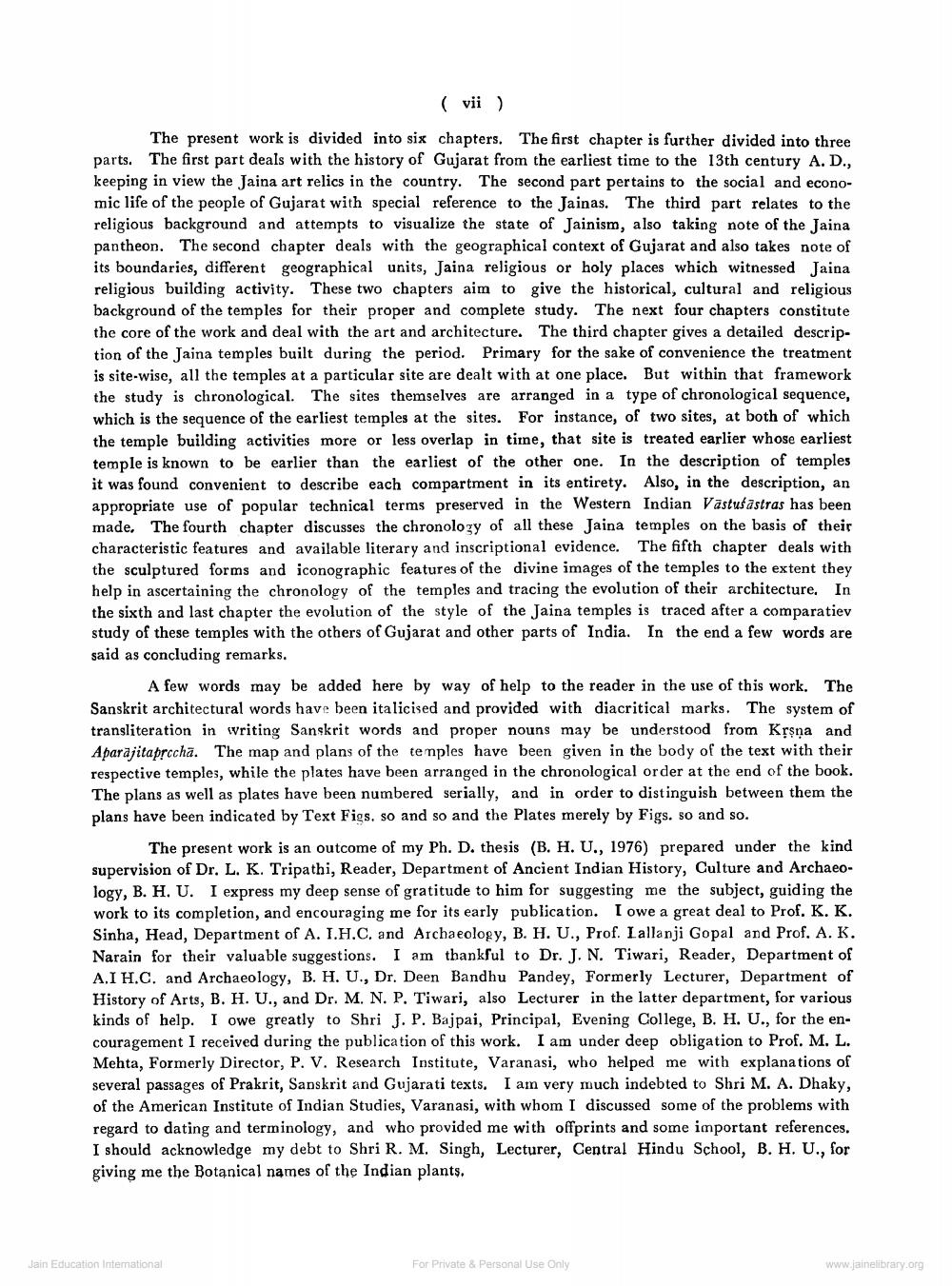________________
(vii)
The present work is divided into six chapters. The first chapter is further divided into three parts. The first part deals with the history of Gujarat from the earliest time to the 13th century A. D., keeping in view the Jaina art relics in the country. The second part pertains to the social and economic life of the people of Gujarat with special reference to the Jainas. The third part relates to the religious background and attempts to visualize the state of Jainism, also taking note of the Jaina pantheon. The second chapter deals with the geographical context of Gujarat and also takes note of its boundaries, different geographical units, Jaina religious or holy places which witnessed Jaina religious building activity. These two chapters aim to give the historical, cultural and religious background of the temples for their proper and complete study. The next four chapters constitute the core of the work and deal with the art and architecture. The third chapter gives a detailed description of the Jaina temples built during the period. Primary for the sake of convenience the treatment is site-wise, all the temples at a particular site are dealt with at one place. But within that framework the study is chronological. The sites themselves are arranged in a type of chronological sequence, which is the sequence of the earliest temples at the sites. For instance, of two sites, at both of which the temple building activities more or less overlap in time, that site is treated earlier whose earliest temple is known to be earlier than the earliest of the other one. In the description of temples it was found convenient to describe each compartment in its entirety. Also, in the description, an appropriate use of popular technical terms preserved in the Western Indian Västusastras has been made. The fourth chapter discusses the chronology of all these Jaina temples on the basis of their characteristic features and available literary and inscriptional evidence. The fifth chapter deals with the sculptured forms and iconographic features of the divine images of the temples to the extent they help in ascertaining the chronology of the temples and tracing the evolution of their architecture. In the sixth and last chapter the evolution of the style of the Jaina temples is traced after a comparatiev study of these temples with the others of Gujarat and other parts of India. In the end a few words are said as concluding remarks.
A few words may be added here by way of help to the reader in the use of this work. The Sanskrit architectural words have been italicised and provided with diacritical marks. The system of transliteration in writing Sanskrit words and proper nouns may be understood from Kṛṣṇa and Aparajitapṛecha. The map and plans of the temples have been given in the body of the text with their respective temples, while the plates have been arranged in the chronological order at the end of the book. The plans as well as plates have been numbered serially, and in order to distinguish between them the plans have been indicated by Text Figs. so and so and the Plates merely by Figs. so and so.
The present work is an outcome of my Ph. D. thesis (B. H. U., 1976) prepared under the kind supervision of Dr. L. K. Tripathi, Reader, Department of Ancient Indian History, Culture and Archaeology, B. H. U. I express my deep sense of gratitude to him for suggesting me the subject, guiding the work to its completion, and encouraging me for its early publication. I owe a great deal to Prof. K. K. Sinha, Head, Department of A. I.H.C. and Archaeology, B. H. U., Prof. Lallanji Gopal and Prof. A. K. Narain for their valuable suggestions. I am thankful to Dr. J. N. Tiwari, Reader, Department of A.I H.C. and Archaeology, B. H. U., Dr. Deen Bandhu Pandey, Formerly Lecturer, Department of History of Arts, B. H. U., and Dr. M. N. P. Tiwari, also Lecturer in the latter department, for various kinds of help. I owe greatly to Shri J. P. Bajpai, Principal, Evening College, B. H. U., for the encouragement I received during the publication of this work. I am under deep obligation to Prof. M. L. Mehta, Formerly Director, P. V. Research Institute, Varanasi, who helped me with explanations of several passages of Prakrit, Sanskrit and Gujarati texts. I am very much indebted to Shri M. A. Dhaky, of the American Institute of Indian Studies, Varanasi, with whom I discussed some of the problems with regard to dating and terminology, and who provided me with offprints and some important references. I should acknowledge my debt to Shri R. M. Singh, Lecturer, Central Hindu School, B. H. U., for giving me the Botanical names of the Indian plants.
Jain Education International
For Private & Personal Use Only
www.jainelibrary.org




